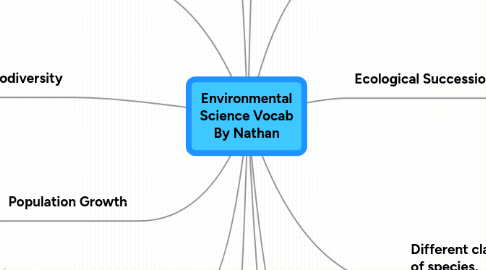
1. Difference in size from least to greatest.
1.1. Organism
1.2. Population
1.3. Community
1.4. Ecosystem
1.5. Biome
2. Carrying Capacity
2.1. Limiting factors
2.1.1. Abiotic factors
2.1.1.1. non-living things that prevent population growth such as climate
2.1.2. Biotic factors
2.1.2.1. Living things that prevent population growth such as predators
2.2. The amount of species that an environment can support and withstand.
3. Biodiversity
3.1. Genetic biodiversity
3.1.1. Same species with a variety of differences.
3.2. Species biodiversity
3.2.1. Same ecosystem with a variety of different species.
3.3. Ecosystem biodiversity
3.3.1. Same environment with a variety of different ecosystems.
3.4. Hotspots
3.4.1. Most biodiverse locations
4. Population Growth
4.1. Population growth rate
4.1.1. how fast a population grows
4.1.2. J-Curve
4.1.2.1. also known as exponential growth which is when it is flat lined and slope in creases rapidly.
4.1.3. S-curve
4.1.3.1. Goes through same process as a J-Curve but levels off at the top
5. Graphing systems
5.1. Food Chain
5.2. Food Web
6. Types of Water Pollution
6.1. Non-point source
6.1.1. When pollution does not have a traceable source and comes from all over the watershed.
6.1.2. such animal waste runoff or any other form of runoff water from a impermeable surface.
6.2. Point source
6.2.1. When pollution comes from a direct source and can be traced back.
6.2.2. pollution comming from a pipeleading directly into a stream or any body of water.
6.3. Inorganic
6.3.1. a type of pollutant than did not come from a biological
6.3.2. Chemical waste, acidity, amonia from food processing,etc...
6.4. Organic
6.4.1. a type of pollutant that comes from a biological source
6.4.2. Detergents, petroleum, tree debris, etc...
6.5. Urbanization
6.5.1. a type of pollution that comes from the construction of new homes or life on new homes changing the shape of the watershed.
7. Different Types of Biomes
7.1. Tundra
7.2. Rainforest
7.3. Tempret deciduous forest
7.4. Coniferous forest
7.5. Desert
7.6. Grasslands/Savannah
7.7. Wetland
8. Transfer of Engery between Trophic Levels
8.1. Producers
8.1.1. 100% energy from sun
8.2. Primary Consumers
8.2.1. 10% energy from Producers
8.3. Secondary Consumers
8.3.1. 10% energy from Primary Consumers
8.4. Tertiary Consumers
8.4.1. 10% energy from Secondary Consumers
8.5. Decomposers
9. Ecological Succession
9.1. Primary succession
9.1.1. When a new ecosystem is established in an area that no ecosystem exisited previously
9.2. Secondary sucession
9.2.1. When an ecosystem restarts after being disturbed by something such as a natural disaster.
9.3. Climax community
9.3.1. When an ecosystem has so much biodiversity that it stops changing.
10. Different classifications of species.
10.1. Threatened species
10.1.1. high risk of becomming endangered
10.2. Endangered species
10.2.1. high risk of becomming extinct
10.3. Indicator species
10.3.1. Species that show weather or not the ecosystem is healthy.
10.4. Pioneer species
10.4.1. First species to inhabbit an ecosystem.
11. Types of Natural Resources
11.1. Renewable resources
11.1.1. a resource that goes through a cycle and is replenished within a human life span.
11.2. Non-renewable resources
11.2.1. A material or energy source that does not go through a cycle or doesnt replenish its self within a human life span
12. Water Sources
12.1. Aquifers
12.1.1. an underground water source
12.2. Water purification
12.2.1. clean used water to be used again
12.3. Desalinization
12.3.1. turn salt water into fresh water by removing the salt from water.
